Wireless Power Bank 2025: Find the Best, Snap On & Go
Every iPhone from the 12 through the current 16 series has a MagSafe ring that turns magnetic wireless power banks from novelty to necessity. Apple’s own battery pack exited when the iPhone 15 switched to USB‑C, so you’re after a third‑party brick that still snaps on with a satisfying click and charges at optimal speed while you walk. These days, the badge that proves it can be Qi2.
If you’re feeling a little lost in all the tech lingo, don’t worry—we’ve got you. In this guide, we’re breaking down the 5 best wireless power banks of 2025 and what really matters when choosing one: Qi or Qi2 compatibility, magnet strength, charging wattage, battery capacity, and more.
Best Wireless Power Banks in 2025
A good portable wireless charger power bank is a cable‑free safety net that has to stay attached, charge quickly, refill itself fast and travel light. The five picks below nail those goals in different ways. Let’s take a close look:
1. EcoFlow RAPID Magnetic Power Bank 10,000 mAh
Long day of meetings and your iPhone is already skating on 20% Snap the EcoFlow RAPID Magnetic Power Bank on as you walk between buildings and you’ll hit 50% before you reach the next elevator—about 40 minutes in ideal conditions thanks to the Qi2-certified full 15 W output.
If you’re carrying a USB-C laptop, flip out the built-in 65 W PD-3.0 cable and it’ll top a 13-inch MacBook Air with roughly eight extra hours of screen-on time or juice an iPhone 15 Pro to 50% in just 25 minutes.
The RAPID’s smart display shows exact wattage and time-to-empty, while the EcoFlow app lets you rename the boot screen, trigger a buzzer when the pack disappears under couch cushions, or cap charge to prolong cell health. N52 magnets and an anti-slip pad stop the 258 g block sliding off during a tram ride, and a hinged kick-stand props your phone for FaceTime at the café.
Under the shell, a car-grade cooling plate and a sensor that checks temperature 50 times a second—over four million times a day, so you won’t have to worry about your power bank or iPhone overheating on summer days.

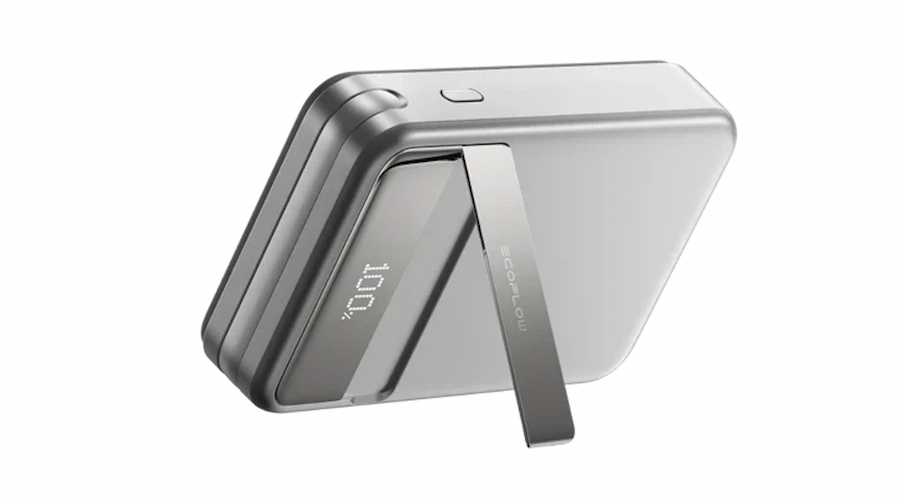
Key features:
Qi2-certified 15 W wireless charging for iPhone 12-16
Built-in 65 W USB-C cable (PD 3.0) powers laptops or tablets without an extra lead
10,000 mAh capacity: ~8 hrs extra on a 13-in MacBook Air or two iPhone recharges
Flash self-recharge: 0 to 70 % in ≈ 33 min via 65 W USB-C input
Smart digital display: live wattage, remaining % and time to full
EcoFlow app control: personalised boot screen, Healthy Charging mode, locator buzzer
N52 magnets + anti-slip coating keep the pack locked in place; folding kick-stand for portrait or landscape viewing
Advanced thermal management: 50 temp checks / second, internal cooling tunnel
Travel friendly: 258 g; 108 × 70 × 22.9 mm; ports—USB-C cable (I/O) + extra USB-C port (I/O)
2. Baseus Magnetic Power Bank 10,000 mAh
Morning commute, two phones in your bag, one cable left at home—this is the gap the Baseus pack fills. Its party trick is simultaneous 7.5W Qi wireless and 20 W wired output, so you can magnet-snap an iPhone while topping up earbuds (or a friend’s handset) over USB-C.
The pack itself refuels in about two hours on a 20 W charger and does pass-through, handy when the only wall socket at the café is already occupied by your latte. A soft-touch PU pad keeps fingerprints off the face, while rounded flanks sit comfortably in your palm on the train.
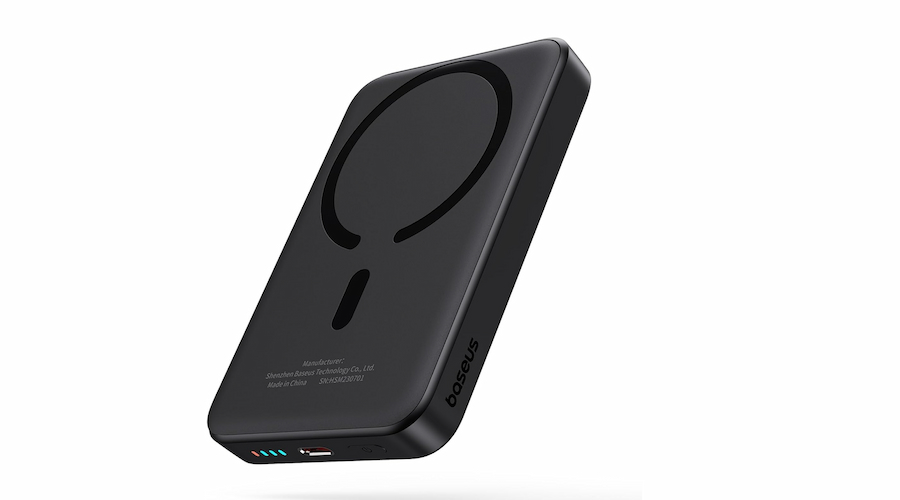

Key features:
7.5 W (Qi) MagSafe-compatible wireless + 20 W PD USB-C (output)
20 W USB-C input — bank recharges < 2 h on a 20 W brick
Pass-through charging for one-plug desk setups
Soft PU charging pad and contoured edges for better grip
3. Anker MagGo Power Bank Ultra-Slim 10,000 mAh
If you hate bulges in your jeans pocket, Anker’s 14.7 mm MagGo slab is the thin 10 K battery pack you’re looking for, truly. Slip it behind an iPhone 15 Pro and the duo is still slimmer than many rugged cases.
Qi2 certification means magnetic 15 W wireless that takes the 15 Pro from flat to 50 % in about 50 minutes; plug a cable into the 30 W USB-C port and you can rescue a Nintendo Switch during a flight lay-over. A matte UV skin resists scratches, while an internal aerogel layer spreads heat so the chassis stays cool to the touch.
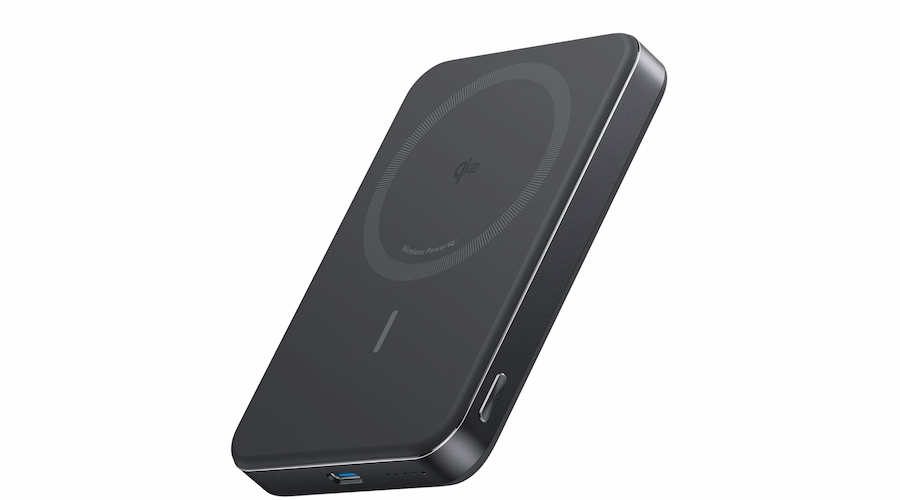

Key features:
Ultra-slim 14.7 mm profile, 10 K cell = ≈1.8 iPhone 15 Pro charges
Qi2-certified 15 W wireless pad + 30 W USB-C PD port
Bidirectional USB-C (fast bank recharge < 2.5 h on 30 W)
Metal frame, matte UV finish, aerogel thermal insulation
4. VRURC T1151 Magnetic Power Bank 10,000 mAh
Budget doesn’t have to mean basic. The VRURC T1151 crams 22.5W PD output, a fold-out USB-C cable, and a MagSafe-compatible pad into a body lighter than a can of Coke (≈190 g).
Wireless peaks at 7.5 W (Qi), so think of it as an emergency top-up while you scroll; the real speed comes via USB-C where an iPhone 14 hits 50 % in half an hour. A silicone finger loop doubles as a stand and keeps the camera unobstructed, so you can video chat while charging.
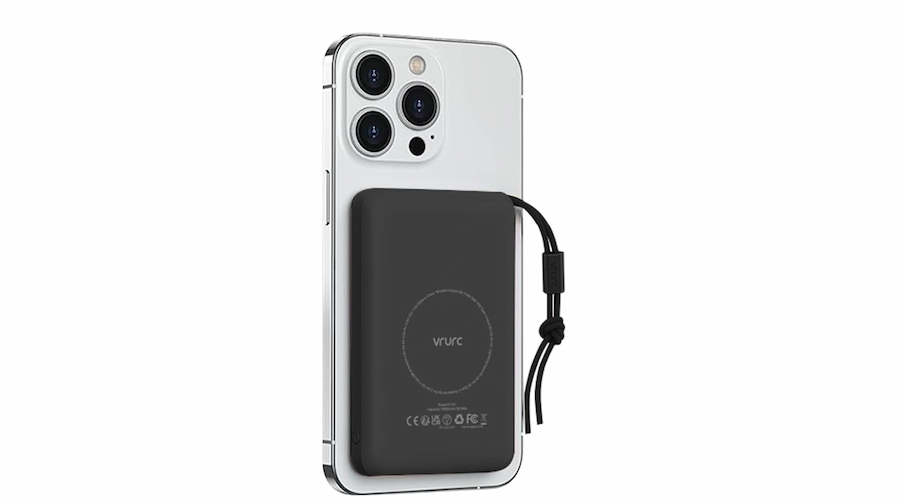

Key features:
7.5 W(Qi) MagSafe-compatible wireless pad
PD 22.5 W USB-C port + 18 W USB-C input
Built-in USB-C cable, finger-loop / stand combo
Smart chip guards against over-charge, short-circuit, over-heat
5. UGREEN Qi2 Power Bank 10,000 mAh
Slip UGREEN’s Qi2 power bank onto the back of your phone and the magnet snaps home with a reassuring click; the 15 W pad immediately starts clawing back charge, and the soft‑to-the-touch shell keeps the combo comfortable in your hand.
At 218 g and roughly card‑deck dimensions, it fits easily in a jeans pocket. Need more speed? Pop a cable into the USB‑C port for 20 W wired output or refill the bank itself on a standard PD charger.
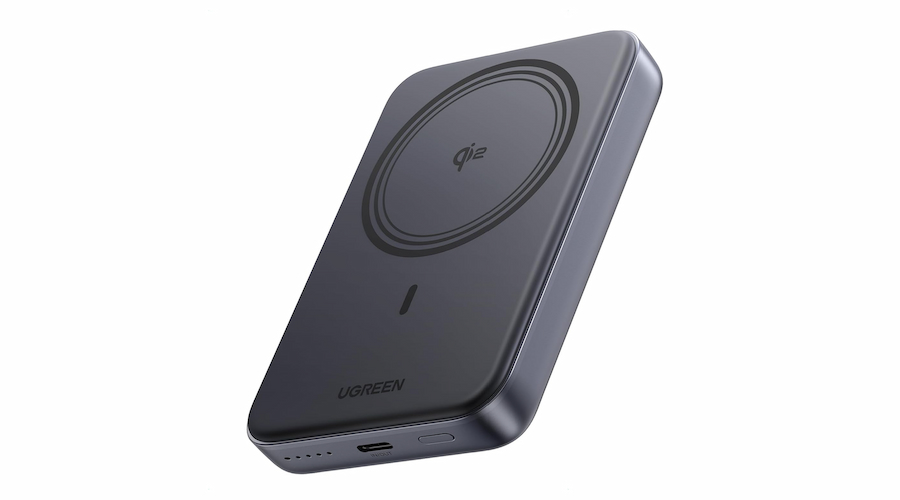

Key features:
Qi2-certified 15 W magnetic wireless charging
20 W USB-C PD input/output for phones and tablets
10,000 mAh cell ≈1–2 full phone charges
Pocketable silhouette, soft‑touch coating for better hold
Factors to Consider Before Buying a Wireless Power Bank
When choosing a wireless power bank, there’s a bit more to think about than just the usual stuff like capacity, size, ports, and wattage. Run through the checklist below and you’ll land on a pack that fits your lifestyle.
Certification & Wireless Charging Speed
The logo to watch now is Qi2. Built by the Wireless Power Consortium with Apple’s help, Qi2 wireless charging power banks keep coils and magnets perfectly aligned and lift any MagSafe-enabled iPhone to the same 15 W speed.
It’s twice as fast as older 7.5W Qi pads that just use a magnetic ring to kinda make it work. So basically, you get MagSafe convenience via Qi2 without the Apple‑tax. That said, if you’re on a budget, those older magnetic Qi power banks still get the job done.
Wired I/O: Output and Input
Wireless is handy, but USB-C still rules for raw speed. Check two numbers:
Output—30 W or higher will fast-charge tablets, handheld consoles, even some laptops; 20 W is fine for phones.
Input—a 65 W 10,000 mAh power bank can refill itself to 70 % in half an hour. Ports that support PD 3.0 play nicely with most modern devices.
Capacity vs Weight
Snap‑on wireless packs stay lean by design—most sit at 5,000 mAh or 10,000 mAh. Both sizes sail under the airline cap, so you can toss them in your cabin bag without declaring a thing. Which to pick?
5K is a safety net: roughly one full iPhone recharge, slim enough to sit flush on mini or standard iPhones.
10K doubles that stamina and still fits a pocket, though weight climbs from ~150 g to ~230 g.
Magnet Strength & Alignment
A magnetic pack is useless if it slips off. You can trust the Qi2 certification, but for other models, look for N52-grade magnets or stated pull-force ratings around 800–1,000 g; that’s strong enough to survive pocket shuffles and bumpy commutes. Rubberised or PU pads add extra grip without scratching the phone.
Thermal Management & Safety
Fast wireless charging generates heat, which ruins battery health and can spark recalls. Choose power banks that tout UL/FCC certification, use cooling plates or aerogel insulation, and sample temperature multiple times per second. Recent recalls of cheap 5 K “Power Pods” are a reminder to steer clear of no-name clones.
Extras That Actually Help
Pass-through charging keeps everything on one wall plug.
Kick-stands turn the bank into a desk dock for video calls.
OLED read-outs or apps show exact watts and let you cap charge at 80 % for battery health.
Built-in cables (30–65 W) save you from rummaging for cords.
Conclusion
Now, all that’s left is matching specs to your routine. Start with certification—Qi2 promises seamless magnetic connection and full 15W wireless charging speed, but if you’re on a budget, a 7.5W Qi portable charger with strong magnets will do. After that, consider the battery capacity, the ports it has, safety features, and any extras like a built-in kickstand. Pick one that checks all the right boxes, and you’ll carry a cable‑free safety net that keeps the battery panic at bay—exactly what a wireless power bank should do.
FAQs
Are wireless power banks safe to use?
Yes—provided you buy from a reputable brand and look for safety marks such as Qi / Qi2, CE, UL or RCM. Certified packs include temperature sensors, short‑circuit protection and cell‑balancing chips that shut the unit down if it overheats.
What is the difference between a wireless charger and a wireless power bank?
A wireless charger is a pad or stand that draws power from a wall outlet; once you unplug it, it stops working. A wireless power bank has its own battery inside, so it can charge devices on the go without being tethered to mains power.
What are the cons of a wireless power bank?
Wireless power banks tend to be slower than wired chargers and may generate more heat, reducing efficiency. They can also be more expensive.
Is a 20,000mAh power bank allowed in flight in Australia?
Yes. A 20,000 mAh pack is about 74 Wh, which is well below the 100 Wh limit for spare lithium batteries and power banks in carry‑on baggage. You may carry it in the cabin (never in checked luggage), though individual airlines can cap the number of spare batteries per passenger, so it’s smart to check their policy before you fly.